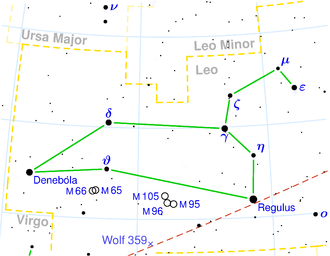NGC 3391
| Galaxy NGC 3391 |
|
|---|---|

|
|
| SDSS recording | |
| AladinLite | |
| Constellation | lion |
|
Position equinox : J2000.0 , epoch : J2000.0 |
|
| Right ascension | 10 h 48 m 56.3 s |
| declination | + 14 ° 13 ′ 11 ″ |
| Appearance | |
| Morphological type | S? |
| Brightness (visual) | 13.0 likes |
| Brightness (B-band) | 13.7 mag |
| Angular expansion | 1 ′ × 0.7 ′ |
| Position angle | 35 ° |
| Surface brightness | 12.5 mag / arcmin² |
| Physical data | |
| Affiliation | LGG 216 |
| Redshift | 0.009860 ± 0.000003 |
| Radial velocity | 2956 ± 1 km / s |
|
Stroke distance v rad / H 0 |
(128 ± 9) x 10 6 ly (39.2 ± 2.7) Mpc |
| history | |
| discovery | Albert Marth |
| Discovery date | April 1, 1864 |
| Catalog names | |
| NGC 3391 • UGC 5920 • PGC 32347 • CGCG 066-027 • MCG + 02-28-014 • IRAS 10462 + 1429 • 2MASX J10485639 + 1413117 • NSA 158802 • USGC U327 NED03 | |
NGC 3391 is a spiral galaxy of Hubble type Sc in the constellation Leo on the ecliptic . It is estimated to be 128 million light years away from the Milky Way and has a diameter of around 100,000 ly.
In the same area of the sky are the galaxies NGC 3367 , NGC 3377 , NGC 3412 , NGC 3419 , among others .
The object was discovered by Albert Marth on April 1, 1864 .
